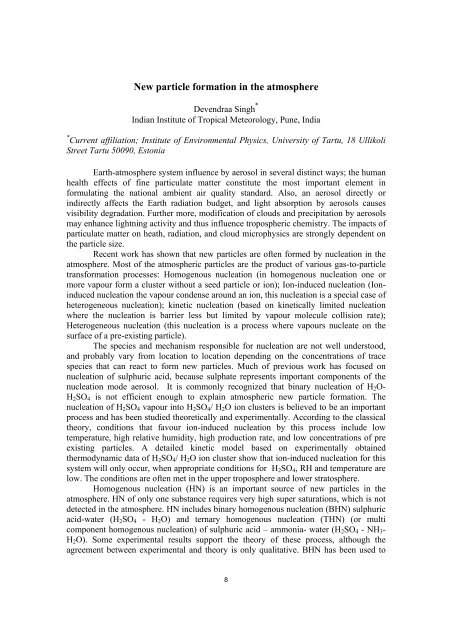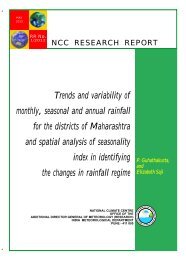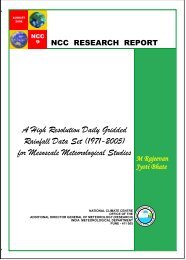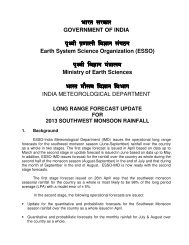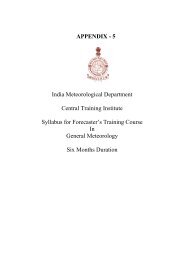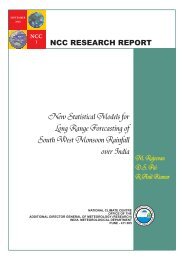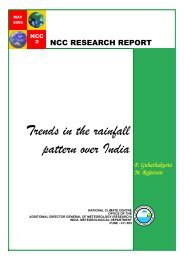BULLETIN OF IMSP - (IMD), Pune
BULLETIN OF IMSP - (IMD), Pune
BULLETIN OF IMSP - (IMD), Pune
- No tags were found...
Create successful ePaper yourself
Turn your PDF publications into a flip-book with our unique Google optimized e-Paper software.
New particle formation in the atmosphereDevendraa Singh *Indian Institute of Tropical Meteorology, <strong>Pune</strong>, India* Current affiliation; Institute of Environmental Physics, University of Tartu, 18 UllikoliStreet Tartu 50090, EstoniaEarth-atmosphere system influence by aerosol in several distinct ways; the humanhealth effects of fine particulate matter constitute the most important element informulating the national ambient air quality standard. Also, an aerosol directly orindirectly affects the Earth radiation budget, and light absorption by aerosols causesvisibility degradation. Further more, modification of clouds and precipitation by aerosolsmay enhance lightning activity and thus influence tropospheric chemistry. The impacts ofparticulate matter on heath, radiation, and cloud microphysics are strongly dependent onthe particle size.Recent work has shown that new particles are often formed by nucleation in theatmosphere. Most of the atmospheric particles are the product of various gas-to-particletransformation processes: Homogenous nucleation (in homogenous nucleation one ormore vapour form a cluster without a seed particle or ion); Ion-induced nucleation (Ioninducednucleation the vapour condense around an ion, this nucleation is a special case ofheterogeneous nucleation); kinetic nucleation (based on kinetically limited nucleationwhere the nucleation is barrier less but limited by vapour molecule collision rate);Heterogeneous nucleation (this nucleation is a process where vapours nucleate on thesurface of a pre-existing particle).The species and mechanism responsible for nucleation are not well understood,and probably vary from location to location depending on the concentrations of tracespecies that can react to form new particles. Much of previous work has focused onnucleation of sulphuric acid, because sulphate represents important components of thenucleation mode aerosol. It is commonly recognized that binary nucleation of H 2 O-H 2 SO 4 is not efficient enough to explain atmospheric new particle formation. Thenucleation of H 2 SO 4 vapour into H 2 SO 4 / H 2 O ion clusters is believed to be an importantprocess and has been studied theoretically and experimentally. According to the classicaltheory, conditions that favour ion-induced nucleation by this process include lowtemperature, high relative humidity, high production rate, and low concentrations of preexisting particles. A detailed kinetic model based on experimentally obtainedthermodynamic data of H 2 SO 4 / H 2 O ion cluster show that ion-induced nucleation for thissystem will only occur, when appropriate conditions for H 2 SO 4 , RH and temperature arelow. The conditions are often met in the upper troposphere and lower stratosphere.Homogenous nucleation (HN) is an important source of new particles in theatmosphere. HN of only one substance requires very high super saturations, which is notdetected in the atmosphere. HN includes binary homogenous nucleation (BHN) sulphuricacid-water (H 2 SO 4 - H 2 O) and ternary homogenous nucleation (THN) (or multicomponent homogenous nucleation) of sulphuric acid – ammonia- water (H 2 SO 4 - NH 3 -H 2 O). Some experimental results support the theory of these process, although theagreement between experimental and theory is only qualitative. BHN has been used to8


